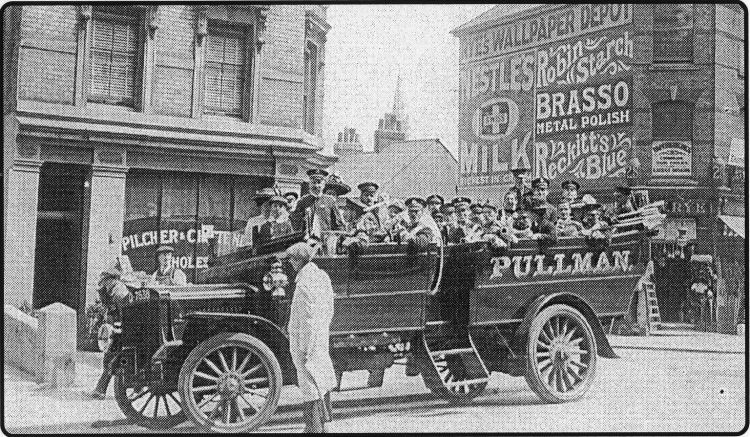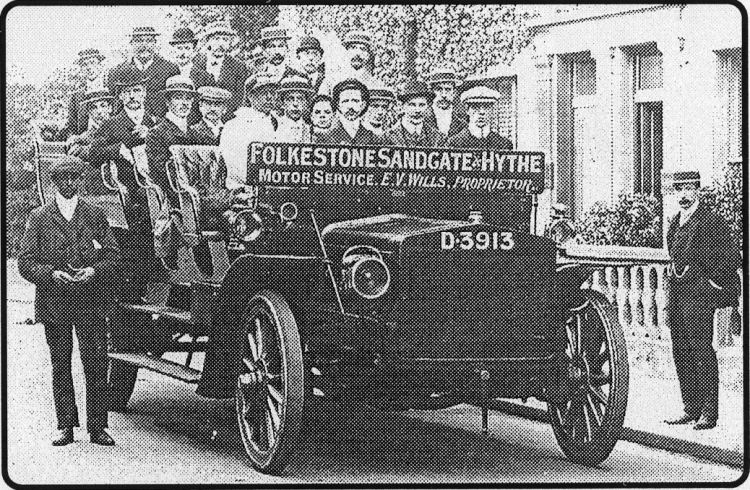
Published 12 April 2001

•< \ .vmsm:? e-mail: hollingsbee@bigfoot.com II
- AW_.
Bus nostalgia
AVIATION history researcher Roy Humphreys, of Hawkinge, has shown me some
fascinating copies of old postcards of early motoring interest that were
shown to him by Peter Wills, of Folkestone, who is a descendant of 'Father'
Ernest Valentine Wills, of Cheriton, one of the bus proprietors who
pioneered public road transport services in the Shepway district.
'Father' or 'Pop' Wills, as he was popularly known, set out to run his own
bus company in the early 1900s, competing with the "Yellow Pots" - a fleet
of charabancs run by Folkestone Motors Ltd.
This company had close ties with local coachbuilders and motor dealers
Maltby Motors, which had their origins in Sandgate. One at least of the
Maltby family was a director.
Another local competitor was John Cann, who started with small MMCs and
later managed a fleet of much bigger vehicles in Folkestone that were called
Cann's Patent Motor Coaches. John Cann objected to the use of the term
'charabanc.'
These Thames Ironworks vehicles were somewhat larger coaches, having a
removable, covered coupe section at the back which must have been a boon in
wet or windy weather.
Very soon the firm had become the London & South Coast Motor Service Ltd,
with John Cann managing director. And, in 1908, John Cann told Thames
Ironworks that eight
coaches built on their chassis clocked up 165,200 miles. The firm went
'bust' around 1914.
The 'Pop' Wills' charabancs were in dark green livery, many of them coming
from the Maltby works, including 'Sandgate Pullmans,' and, by the time he
sold out to the East Kent Road Car Company in the mid-1920s he had around 27
vehicles.
Folkestone Motors, not to be confused with the later Folkestone District
Road Car Co, was up and running as a registered company by mid-1901. It
began running a motor service between Folkestone and Hythe from July 23,
1901.
‘Mustard Pots’
The firm seems to have favoured yellow livery from the outset, although at
first they were blue-black picked out in yellow and with yellow panels. It
was probably when they became predominantly yellow they earned the nicknames
of "Yellow Pots" or "Mustard Pots."
John Cann also seems to
have liked yellow, two at least of his early cars were black and primrose
with primrose wheels.
'Father' Wills came to Folkestone from Chilham with his wife Rose Annie to
open a garage at Park Road, Cheriton, in 1903.
He later took over an old building on the opposite side of the road to house
his fleet of coaches and did so well he eventually took over the old "Yellow
Pots" of Folkestone Motors Ltd, before selling out to the East Kent.
His pride and joy seems to have been a 75hp monster capable of carrying 32
passengers at speeds considered quite remarkable in their day.
When the railway track between Folkestone and Dover was blocked by a
landslide early in the First World War, Wills' coaches ferried thousands of
passengers between the two towns. And the service was continued for some
time after the war.
Sadly, both Ernest Wills, 80 and his son Mr E.B. Wills, who ran the Park
Road garage, died the same year, in 1956.
WRITING to the Herald from New Zealand, Don Love, a war veteran, who left
Folkestone for a new life 'down under' in 1949, tells me he is shortly going
on a trip down memory lane with 50 other veterans on a return visit to
Korea. Don served in the NZ army in Korea from 1951-53 and says one of the
scheduled places to visit is the UN war cemetery at Pusun, where most of the
Commonwealth troops who were killed are buried. And he writes: "I believe at
least one soldier from Folkestone is buried in the cemetery." He says he
could try and get a photo of the grave and send it to them. Don can be
contacted at 35 Queen Street, Feilding, New Zealand (tel: 06 323 7278.)
PETER Wills’ pictures include this one, above, of Folkestone Brass Band all
set to be taken to the Leas bandstand in a 1913 Maltby charabanc, a
30-seater. It is standing in Foord Road at the junction with New Street.
Rye’s wallpaper depot seen in the photograph is now occupied by Dunn’s
plumbing. In the background, in the original picture, is the spire of the
now demolished St Michael’s Church, at Dover Road. The other photograph,
right, is of an all-male outing group aboard a 1908 Maltby-built ‘Sandgate
Pullman.’ Both were owned by ‘Pop’ Ernest Wills of Cheriton.

 |
Sing-song’ entertainment would "vulgarise’town
*1 QH1 A GOVERNMENT inspector heading an inquiry into the Folkestone and
Cheriton sch ernes for a Tramway system serving both districts was told
an overhead power line system would be £6.000 cheaper than the con-duit-in-the-road
system proposed by Folkestone Council. The Folkestone scheme would cost
£30,697. At the eleventh hour Cheriton learned that Folkestone was axing
a proposed line from Sandgate Rond to the Central Station which they
badly needed. Faccd with this setback. Cheriton. without consulting the
ratepayers, axed part of its own scheme. The Herald criticised a
"singsong" scheme for Marine Gardens entertainment. morning, afternoon
and evening. This, it said, would "vulgarise the charming locality" and
annoy nearby residents. Happily, the scheme was thrown out by a large
majority. Winston Churchill, who later bccame the UK's wartime leader,
gave a talk at the Pleasure Gardens Theatre, on his exciting adventures
in the Boer War. as official Morning Post war correspondent. Winston was
captured by the Boers, but he escaped.
snow mis taster nocKey and soccer programme
|
«• nr<l EASTER at Folkestone came too early and was one of the bleakest
ever, as snow fell heavily on the Saturday and part of the international
hockey festival programme had to be abandoned. At the 25th anniversary
dinner of the Folkestone Optimist Hockey Club in February, it had been
predicted the 1951 Easter Hockey Tournament would be worth at least
£15,000 to the town. Folkestone Town's soccer match with Sittingbourne
also had to be abandoned with the score at 1-1. but over the Easter
holiday they beat Margate 4-1 and Betteshanger CW 1-0. James David
Hayley, MC. DCM, of Surrcnden Road. Folkestone put aside his uniform for
the last time on retiring from the Army after 50 years. It brought to an
end one chapter in a unique family record of 150 years almost continuous
service to their country, which began with Jim's grandfather, who joined
the Queen's Royal West Surrey Regiment in the mid 1800s. And Jim's three
sons, all warrant officers, said the Herald's former midweek paper, the
Gazette, were all set to better the record. Warrant Officer James Hayley
earned the MC in 1916 when he had to take command in France after all
battalion officers were killed.
|
Marine Gardens Pavilion opening ends campaign
*1 QOC MARINE Gardens Pavilion was officially D opened by the Mayoress
of Folkestone, Mrs EJ. Bishop, who unlocked the building with a solid
gold key, admitting a large gathering invited by the Mayor and Mayoress
to an official reception, and unveiled a commemorative plaque. The
opening was the culmination of years of argument and debate about the
need for a all-weather band pavilion for the resort, parliamentary
powers having been obtained back in 1920. The hall, based on the
Westbrook Pavilion, Margate, was built by Folkestone contractor Otto
Marx and had seating for 1,500. The Herald report of the event occupied
three broadsheet columns and included the names of all those who
accepted invitations to attend. Widespread efforts were being made to
encourage people to seek a new life by emigrating 'down under' to
Australia with a scries of public meetings as Britain's unemployment
figures reached 1.25 million. On the same page the poor state of British
agriculture was highlighted by a speaker who told of the young farming
talent that was being lost to emigration. A Hythe editorial slated the
Town Council for not moving with the times and buying a small motor
lorry instead of a horse and cart!
|
Snot leopard had escaped from John Aspinall park
a^/j JOHN Aspinall identified a rare clouded JLtJ IO leopard shot by an
Elmsted farmer as one that escaped from Howletts’ wildlife park, near
Canterbury some 8 months before. It weighed only 18lbs. Another had been
recaptured. He said they were the only ones to have escaped. At the time
of the shooting he was preparing to open a walk-through wild life park
at Lympnc. and there had been fears that animals might escape. The
Tories on Shepway District Council were reeling from the shock decision
of the Council chairman Cllr Alan Burrage not to seek re-election in
May. He was a member of Lydd Town Council and a former borough mayor.
Nine councillors decided not to seek re-election and 14 were being
returned unopposed. Nearly 70 Council homes were being planned for
Reachfields estate on former Army land in Dymchurch Road, Hythe in a
scheme costing £750,000. And 47 more houses were planned at Downs Road,
Folkestone. But starter homes planned for Hawkinge at a disused piggery
site were given the thumbs down by Whitehall after objections that it
was in an area of great landscape value. "Concrete Lego speculators have
been afforded full licence to convert this holiday town Into an
architectural nightmare” wrote a reader soon after moving here having
fallen in love with the district on a visit from London. |
|



